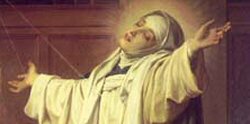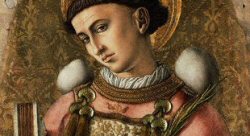 From the Daily Mail
From the Daily MailBy Simon Caldwell
Photo at left: Mother Ricarda Beauchamp Hambrough let Jews hide in the Casa di San Brigida convent in Rome during the Second World War
A little-known English nun who helped to hide Italian Jews from the Nazis in wartime Rome is being considered as a possible saint.
Mother Ricarda Beauchamp Hambrough is credited with playing a vital role in saving the lives of more than 60 Jews by smuggling them into her convent.
The Bridgettines, the order to which she belonged, have now applied to the Vatican for permission to open her cause for sainthood.If granted she will become one of four British women whose sainthood cases are under consideration by the Church.
The early stages of her cause will involve the examination of her life for evidence of ‘heroic virtue’, before two miracles will be sought to confirm her saintly status.
But if it progresses swiftly, she could become the first British woman saint since 1970 when Pope Paul VI canonised three women among 40 English and Welsh saints who died as martyrs in the Protestant Reformation.
Mother Ricarda was born Madaleina Catherine in London on 10 September 1887 and was received into the Roman Catholic Church in Brighton when she was four years old after her Anglican parents, Windsor and Louise, converted to the faith.
Little is known about her childhood but as a young woman she fell under the influence of Father Benedict Williamson, a London-based Benedictine monk, and in 1912, at the age of 24, she travelled to Rome to become a nun.
She was following in the footsteps of a group of three other English girls who had set out a year earlier wanting to join the Bridgettines, a 14th century order which had all but died out until it was re-established in 1911 by Blessed Mary Elizabeth Hasselblad, a Swedish convert from Lutheranism.
She took the religious name Ricarda and was soon chosen as the assistant to Blessed Mary Elizabeth, the abbess.
In the following decades she was at her superior’s side as the order won canonical approval from the Pope and, attracting a large number of vocations, began to open religious houses in Sweden, England, India and Italy.
The order also secured a mother house in Piazza Farnese in historic Rome, a grand building standing on the site of the house of the order’s original founder, St Bridget, a patron saint of Europe.
But within years of moving into new home war broke out and the activities of Mother Ricarda and her fellow nuns were soon concentrated on helping the victims of the conflict.
Pope Pius XII secretly ordered the religious houses of Rome to shelter Jews after the Gestapo seized 1,007 Jews during a sweep of the city on 16 October 1943.
He had protested vigorously to the Germans about the round-up but none of those arrested was released.
Mother Ricarda and Mother Mary Elizabeth then willingly gave refuge to scores of Italian Jews, Communists and Poles fleeing in terror from the Nazis.
A source within the Bridgettines has confirmed that Mother Ricarda was at the heart of the enterprise in hiding refugees.
She said: ‘We were helping many Jewish people during the war and Mother Ricarda was helping Mother Elizabeth to hide them.’
Mother Ricarda’s efforts to save Jewish lives is bound to feature strongly in persuading the Vatican that she is a saint – as it was also a factor in her abbess’s own swift elevation to beatification.
This was apparent when Pope John Paul II beatified Blessed Mary Elizabeth in 1999, noting in his homily the ‘care and concern’ Ricarda’s former boss had shown to ‘the persecuted Jewish people’ and ‘those who suffered because of racial laws’.
A year after the war, the Chief Rabbi of Rome, Israel Zolli, a friend of both Ricarda and Blessed Mary Elizabeth, converted to the Catholic faith – partly because he was so impressed by the efforts of Catholics to save Jewish lives. He took as his Christian name Eugenio – after the Pope Pius, the previous Eugenio Pacelli.
Pope Pius was severely criticised after his death for not speaking out directly against the Holocaust, but he was convinced this would have backfired both against the Jews and Church.
However, his policy of opening up the churches to those fleeing persecution was that an estimated 85 per cent of Roman Jews were able to escape the Nazis.
Blessed Mary Elizabeth died in 1957, and Mother Ricarda succeeded her as abbess until her own death on 26 June 1966 at the age of 79.
The pair are buried in the same grave in the convent church where they hid so many people from persecution.
Once the nuns have established that Mother Ricarda lived a life of heroic virtue the file on her life will be passed over to the Vatican.
Two miracles are then needed be fore she can be made a saint – the first for her beatification when she will be declared Blessed and the second for her ultimate canonisation.
A file is also being prepared on the cause for sainthood of Katherine Flanagan, a Londoner who joined the Bridgettines a year before Ricarda.
Father Ray Blake, the parish priest of St Mary Magdalen Church in Brighton, where Ricarda was baptised, said he was ‘terribly excited’ at the prospect of having a saint associated with his church.























No comments:
Post a Comment